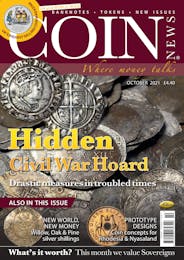
Unfairly overlooked?
THIS month we start a new four part series by David Seaman on the Maundy Money of William and Mary. A specialist subject I think you’ll agree but one which I am sure will be of interest no matter what you collect—and reading Part I got me thinking, why is Maundy Money still relatively cheap? Ok, so in recent years prices have increased, but not to the same degree as the prices of other coins have and I don’t understand why.
For those of you who don’t know, Maundy Money is all related to alms and Easter. In the Christian calendar Maundy Thursday (or Holy Thursday) is the day before Good Friday, the day Jesus was crucified, and traditionally it was a time for the rich to give back to the poor. The name “Maundy” and the Maundy ceremony itself derive from an instruction, or mandatum, of Jesus at the Last Supper that his followers should love one another. In the Middle Ages, English monarchs used to wash the feet of beggars in imitation of Jesus, and presented gifts and money to the poor. Over time, additional money was substituted for the clothing and other items that had once been distributed. The British Monarch no longer washes the feet of the poor but the idea still survives in the Maundy service which is held in a different church (usually a cathedral) every year and where Her Majesty the Queen gives gifts of money to specially selected recipients from the local community. Things have been different during lockdown of course with the services cancelled and the recipients receiving their gifts by post—but the principle remains! The number of recipients and the amount of money (it’s all symbolic nowadays) is determined by the age of the monarch, something started by King Henry IV. The earliest record of a monarch giving coins was in 1213 when King John distributed silver to the poor and originally the coins, all pennies, were originally taken from everyday circulating coinage but in the reign of Charles II a special undated set of one penny, two pence, three pence and four pence was struck especially for the Maundy ceremony. In 1670 the first dated set appeared. The coins in use today have a design that dates back to 1822 and the reign of George IV, with the obverse of Queen Elizabeth’s coins still bearing the Mary Gillick portrait of her Majesty rather than one of the more up to date versions. In most years there are fewer than 2,000 of the sterling silver (.925) Maundy sets struck which means in numismatic terms they are really quite rare indeed.
This being the case, why haven’t prices gone up and up and up in recent years? After all if you had any other coin from the late 17th century that was one of only a few thousand and in extremely fine condition (they were never intended for circulation and are usually found still in their sets so are almost always in “good nick”) you’d be paying far more than you are for a Maundy piece, but why? Perhaps there is something to the argument that because they weren’t intended for use, and thus are often in EF condition, they don’t have the same appeal as finding an EF circulation coin that’s 200+ years old, and that may be true, but I ask you this—why do proofs and specimens never intended for circulation and thus generally in EF or better always command such high premiums? If you think logically about a Maundy set it’s a selection of precious metal coins, usually in excellent condition, of which very few (numismatically speaking) were issued. Put all that together and surely you have a set worth thousands upon thousands don’t you? Well no, actually, Maundy just doesn’t attract the prices you might expect and I for one think it’s been unfairly overlooked. I hope David’s articles will go some way to addressing that. I also wish I’d not written this “comment” and not included the articles until after I’d had a chance to go round buying up Maundy sets myself . . . ah, hindsight, it’s such a wonderful thing!









